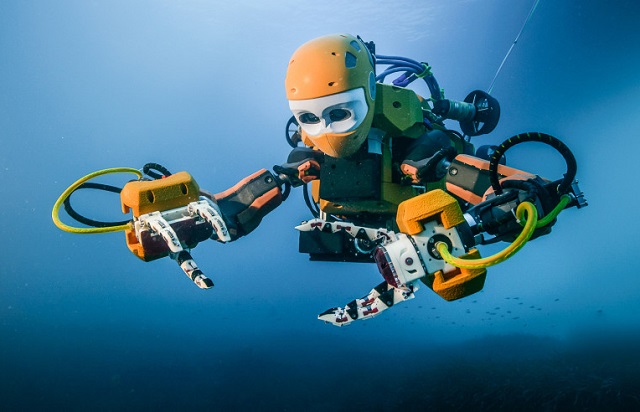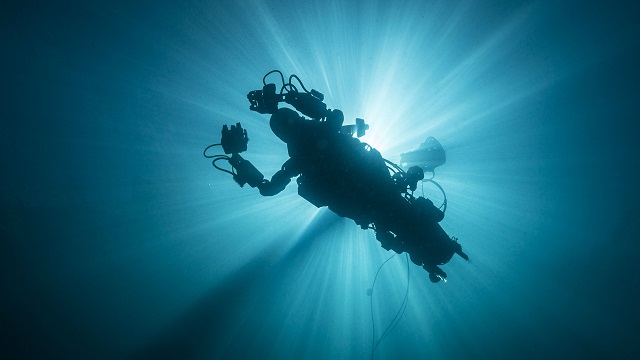Humanoid Robotic Diver Makes Maiden Voyage
U.S.-based Stanford University’s robotic diver, OceanOne, has made its maiden voyage to recover treasure from King Louis XIV's wrecked flagship.
The robot is powered by artificial intelligence and haptic feedback systems, allowing human pilots an unprecedented ability to explore the depths of the oceans in high fidelity.
Every aspect of the robot’s design is meant to allow it to take on tasks that are either dangerous – deep-water mining, oil-rig maintenance or underwater disaster situations like the Fukushima Daiichi power plant – or simply beyond the physical limits of human divers.
 The wreck of La Lune is situated in Mediterranean waters 100 meters deep. The vessel sank in 1664, 20 miles off the southern coast of France, and no human had touched the ruins – or the countless treasures and artifacts the ship once carried – in the centuries since.
The wreck of La Lune is situated in Mediterranean waters 100 meters deep. The vessel sank in 1664, 20 miles off the southern coast of France, and no human had touched the ruins – or the countless treasures and artifacts the ship once carried – in the centuries since.
With guidance from a team of deep-sea archaeologists who had studied the site, Dr Oussama Khatib, a professor of computer science at Stanford, has sat in a boat, using a set of joysticks to control OceanOne at the wreck site.
The concept for OceanOne was born from the need to study coral reefs deep in the Red Sea, far below the comfortable range of human divers. No existing robotic submarine can dive with the skill and care of a human diver, so OceanOne was conceived and built from the ground up, a successful marriage of robotics, artificial intelligence and haptic feedback systems.
OceanOne is roughly five feet long from end to end, its torso features a head with stereoscopic vision that shows the pilot exactly what the robot sees, and two fully articulated arms. The “tail” section houses batteries, computers and eight multi-directional thrusters.
Each fully articulated wrist is fitted with force sensors that relay haptic feedback to the pilot’s controls, so the human can feel whether the robot is grasping something firm and heavy, or light and delicate. (Eventually, each finger will be covered with tactile sensors.) The ‘bot’s brain also reads the data and makes sure that its hands keep a firm grip on objects, but that they don’t damage things by squeezing too tightly.

In addition to exploring shipwrecks, this makes it adept at manipulating delicate coral reef research and precisely placing underwater sensors.
“You can feel exactly what the robot is doing,” Khatib said. “It’s almost like you are there; with the sense of touch you create a new dimension of perception.”
The pilot can take control at any moment, but most frequently won’t need to lift a finger. Sensors throughout the robot gauge current and turbulence, automatically activating the thrusters to keep the robot in place. And even as the body moves, quick-firing motors adjust the arms to keep its hands steady as it works. Navigation relies on perception of the environment, from both sensors and cameras, and these data run through smart algorithms that help OceanOne avoid collisions. If it senses that its thrusters won’t slow it down quickly enough, it can quickly brace for impact with its arms, an advantage of a humanoid body build.
The humanoid form also means that when OceanOne dives alongside actual humans, its pilot can communicate through hand gestures during complex tasks or scientific experiments.
“We connect the human to the robot in very intuitive and meaningful way. The human can provide intuition and expertise and cognitive abilities to the robot,” Khatib said. “The two bring together an amazing synergy. The human and robot can do things in areas too dangerous for a human, while the human is still there.”
Khatib hopes that the robot will one day take on highly skilled underwater tasks too dangerous for human divers, as well as open up a whole new realm of ocean exploration.

that matters most
Get the latest maritime news delivered to your inbox daily.
“OceanOne will be your avatar,” Khatib said. “The intent here is to have a human diving virtually, to put the human out of harm’s way. Having a machine that has human characteristics that can project the human diver’s embodiment at depth is going to be amazing.”
In addition to Stanford, the development of the robot was supported by Meka Robotics and the King Abdullah University of Science and Technology (KAUST) in Saudi Arabia.
